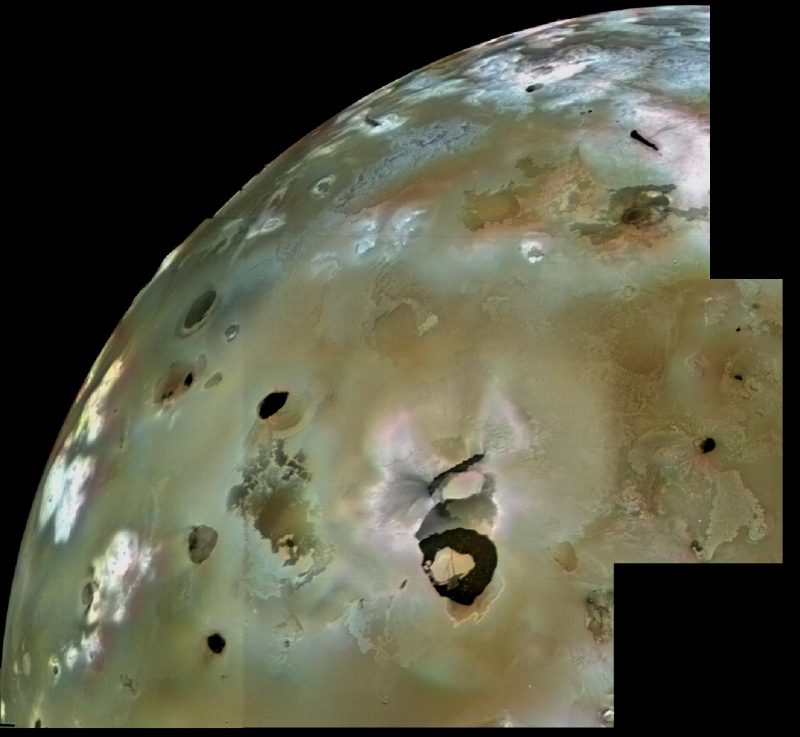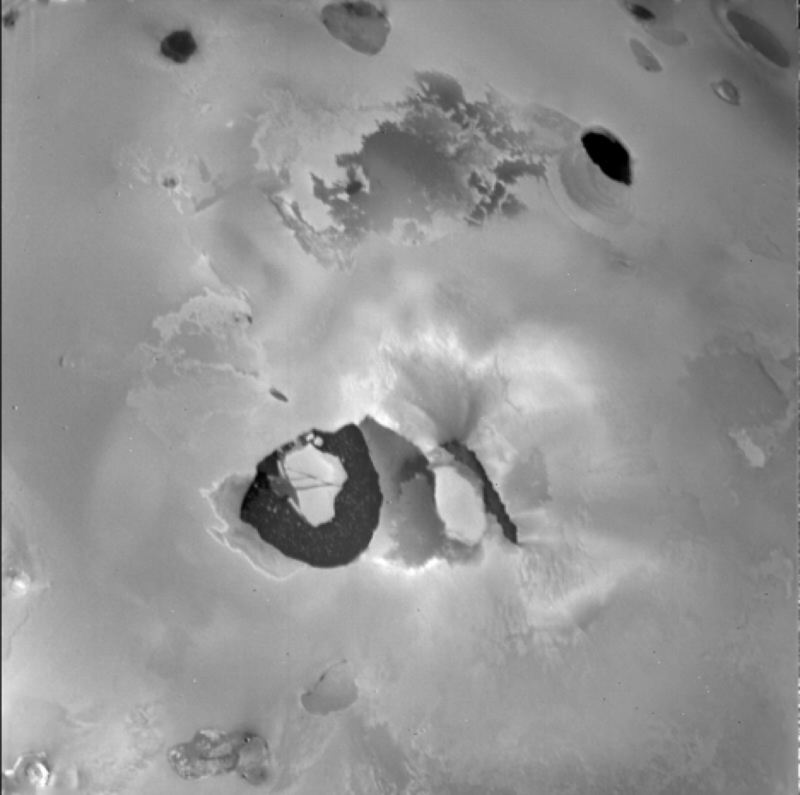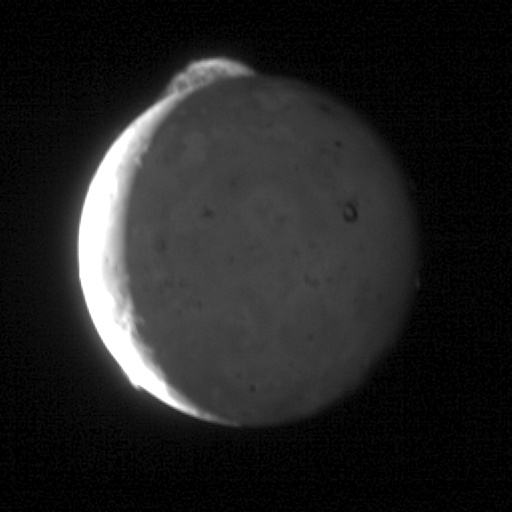

View larger. | Voyager 1 image mosaic – acquired in 1979 – showing a huge area of the volcanic plains on Jupiter’s moon Io. Numerous volcanic calderas and lava flows are visible here. Loki Patera, an active lava lake, is the large, U-shaped black feature, about in the center, toward the bottom of this image. Image via NASA PhotoJournal.
Jupiter’s moon Io is a world of active volcanoes, and Loki Patera is the largest of these, a great depression in the moon’s surface some 126 miles (202 km) across. An active lava lake resides in this depression, and the molten lava there is thought to be directly connected to a magma reservoir below. Above, the lake is likely covered over by a thin, solidified crust. Scientists peering through earthly telescopes have seen this area as continuously active. They think that the crust overlying the lake occasionally gives way, causing a brightness increase. In fact, Loki’s periodic eruptions are so regular that an astronomers has predicted one for this month. Loki is expected to erupt again in mid-September 2019, according to astronomer Julie Rathbun of the Planetary Science Institute based in Tucson, Arizona.
She presented this work today (September 17, 2019) at the joint meeting of the European Planetary Science Congress and the AAS Division for Planetary Sciences in Geneva, Switzerland. She said in a statement that, if Loki behaves as expected, it:
…should erupt in September 2019, around the same time as the EPSC-DPS joint meeting.
Rathbun added:
We correctly predicted that the last eruption would occur in May of 2018. Volcanoes are so difficult to predict because they are so complicated. Many things influence volcanic eruptions, including the rate of magma supply, the composition of the magma — particularly the presence of bubbles in the magma, the type of rock the volcano sits in, the fracture state of the rock, and many other issues.
We think that Loki could be predictable because it is so large. Because of its size, basic physics are likely to dominate when it erupts, so the small complications that affect smaller volcanoes are likely to not affect Loki as much.
In 2002, Rathbun published a paper showing that Loki’s eruption schedule had been approximately every 540 days during the 1990s. It currently appears to be approximately every 475 days. She explained:
Loki is the largest and most powerful volcano on Io, so bright in the infrared that we can detect it using telescopes on the Earth.
Will Loki erupt this month? This week, as Rathbun suggested? She reminded us:
… you have to be careful because Loki is named after a trickster god, and the volcano has not been known to behave itself. In the early 2000s, once the 540 day pattern was detected, Loki’s behavior changed and did not exhibit periodic behavior again until about 2013.
We’ll keep you updated.

View larger. | The Voyager 1 spacecraft acquired this image of the volcano Loki on Jupiter’s moon Io in ___. As Voyager was sweeping past, the main eruptive activity came from the lower left of the dark linear feature (perhaps a rift) in the center. Below is the “lava lake,” a U-shaped dark area about 120 miles (200 km) across.
By the way, volcanos on Earth are driven by heat produced within Earth via the radioactive decay of isotopes in our planet’s mantle and crust, and also via the primordial heat leftover from Earth’s formation.
The source of Io’s heat is very different. Io’s heat is due to tidal frictional heating caused by the continual flexing of Io by the gravity of Jupiter and Europa, another of Jupiter’s satellites.

A massive volcanic plume erupts from a volcano the surface of Jupiter’s moon Io. This plume isn’t from Loki, but, still, it’s cool, isn’t it? Image via NASA/ JHU-APL/ SRI.
Bottom line: A planetary scientists predicts that Loki, the largest volcano on Jupiter’s moon Io, will erupt in September, 2019.
from EarthSky https://ift.tt/2LWGTVJ


View larger. | Voyager 1 image mosaic – acquired in 1979 – showing a huge area of the volcanic plains on Jupiter’s moon Io. Numerous volcanic calderas and lava flows are visible here. Loki Patera, an active lava lake, is the large, U-shaped black feature, about in the center, toward the bottom of this image. Image via NASA PhotoJournal.
Jupiter’s moon Io is a world of active volcanoes, and Loki Patera is the largest of these, a great depression in the moon’s surface some 126 miles (202 km) across. An active lava lake resides in this depression, and the molten lava there is thought to be directly connected to a magma reservoir below. Above, the lake is likely covered over by a thin, solidified crust. Scientists peering through earthly telescopes have seen this area as continuously active. They think that the crust overlying the lake occasionally gives way, causing a brightness increase. In fact, Loki’s periodic eruptions are so regular that an astronomers has predicted one for this month. Loki is expected to erupt again in mid-September 2019, according to astronomer Julie Rathbun of the Planetary Science Institute based in Tucson, Arizona.
She presented this work today (September 17, 2019) at the joint meeting of the European Planetary Science Congress and the AAS Division for Planetary Sciences in Geneva, Switzerland. She said in a statement that, if Loki behaves as expected, it:
…should erupt in September 2019, around the same time as the EPSC-DPS joint meeting.
Rathbun added:
We correctly predicted that the last eruption would occur in May of 2018. Volcanoes are so difficult to predict because they are so complicated. Many things influence volcanic eruptions, including the rate of magma supply, the composition of the magma — particularly the presence of bubbles in the magma, the type of rock the volcano sits in, the fracture state of the rock, and many other issues.
We think that Loki could be predictable because it is so large. Because of its size, basic physics are likely to dominate when it erupts, so the small complications that affect smaller volcanoes are likely to not affect Loki as much.
In 2002, Rathbun published a paper showing that Loki’s eruption schedule had been approximately every 540 days during the 1990s. It currently appears to be approximately every 475 days. She explained:
Loki is the largest and most powerful volcano on Io, so bright in the infrared that we can detect it using telescopes on the Earth.
Will Loki erupt this month? This week, as Rathbun suggested? She reminded us:
… you have to be careful because Loki is named after a trickster god, and the volcano has not been known to behave itself. In the early 2000s, once the 540 day pattern was detected, Loki’s behavior changed and did not exhibit periodic behavior again until about 2013.
We’ll keep you updated.

View larger. | The Voyager 1 spacecraft acquired this image of the volcano Loki on Jupiter’s moon Io in ___. As Voyager was sweeping past, the main eruptive activity came from the lower left of the dark linear feature (perhaps a rift) in the center. Below is the “lava lake,” a U-shaped dark area about 120 miles (200 km) across.
By the way, volcanos on Earth are driven by heat produced within Earth via the radioactive decay of isotopes in our planet’s mantle and crust, and also via the primordial heat leftover from Earth’s formation.
The source of Io’s heat is very different. Io’s heat is due to tidal frictional heating caused by the continual flexing of Io by the gravity of Jupiter and Europa, another of Jupiter’s satellites.

A massive volcanic plume erupts from a volcano the surface of Jupiter’s moon Io. This plume isn’t from Loki, but, still, it’s cool, isn’t it? Image via NASA/ JHU-APL/ SRI.
Bottom line: A planetary scientists predicts that Loki, the largest volcano on Jupiter’s moon Io, will erupt in September, 2019.
from EarthSky https://ift.tt/2LWGTVJ

Aucun commentaire:
Enregistrer un commentaire